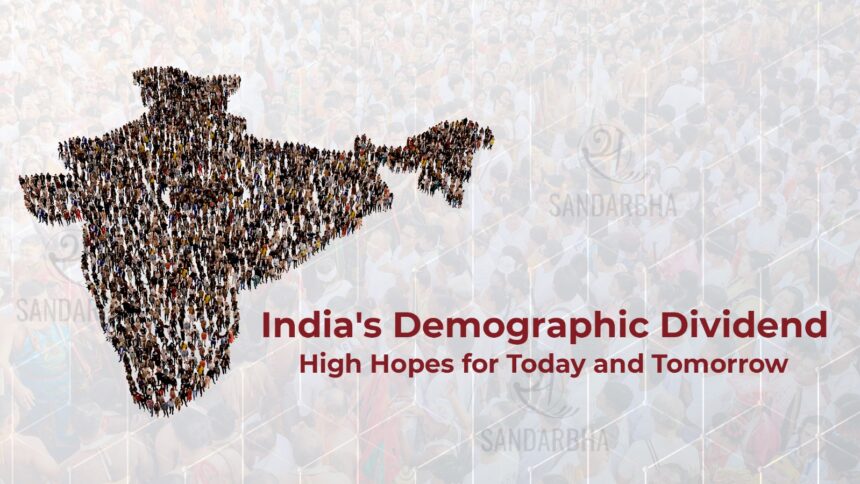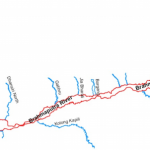India, with its diverse culture, rich history, and rapidly growing economy, stands at the threshold of a significant demographic advantage known as the “demographic dividend.” This phenomenon refers to a period when the working-age population surpasses the dependent, non-working age population, presenting a unique opportunity for economic growth and development. As India’s youthful population continues to rise, there are high hopes that this demographic dividend will not only shape the country’s present but also lay the foundation for a prosperous future.
Brief Overview:
Since gaining independence in August 1947, India has witnessed a substantial increase in its population, nearly tripling over the course of almost six decades. In the 1950s, the average Indian woman gave birth to over six children, leading to an annual population growth rate of about 2% during the latter half of the 20th century. This rapid expansion raised concerns about the potential consequences of such prolific population growth.
However, these concerns are now considered outdated. In recent years, India’s fertility rate has declined, with women currently having an average of two children. Concurrently, mortality rates have decreased due to increased life expectancy, driven by increased incomes and improved access to healthcare and education. Projections suggest that the population is poised to gradually decline by the 2060s.
Presently, individuals under the age of 25 constitute nearly half (47%) of the nation’s population. This youthful demographic is anticipated to play a pivotal role in steering India’s economic development for decades to come.
The Demographic Landscape:
India is home to over 1.3 billion people, making it the second-most populous country globally. One of the defining features of India’s demographic profile is the significant proportion of its population below the age of 35. According to estimates, more than 65% of the population is under 35 years old, presenting a demographic scenario that is the envy of many developed nations facing an aging population crisis.
Also read: Know India Programme for Diaspora Youth
The Working-Age Advantage:
The demographic dividend occurs when there is a larger share of the population in the working-age group (15-64 years), resulting in a higher potential for economic productivity. This situation arises when there is a decline in fertility rates, leading to a bulge in the working-age population relative to dependents (children and elderly). India is currently experiencing this demographic shift, which is expected to last for several decades.
Economic Implications:
The economic implications of India’s demographic dividend are vast and multifaceted. A youthful and dynamic workforce can contribute significantly to economic growth, innovation, and productivity. With the right policies in place, the working-age population can drive various sectors, including manufacturing, services, and technology, propelling India into the ranks of global economic powerhouses.
However, it is crucial to note that the realization of the demographic dividend is contingent on effective utilization of this workforce. This requires investments in education, skill development, and job creation to ensure that the burgeoning youth population is equipped with the tools necessary to contribute meaningfully to the economy.
Challenges on the Horizon:
While the demographic dividend presents immense opportunities, it also comes with its set of challenges. Ensuring that the workforce is skilled and employable is a priority. Education and vocational training must be aligned with the needs of the job market to bridge the existing skill gap. Additionally, providing meaningful employment opportunities and fostering entrepreneurship are essential to fully harness the potential of the demographic dividend.
Another challenge is managing the urbanization that accompanies a youthful population. As more young people migrate to urban areas in search of better opportunities, there is a need for well-planned urban development, infrastructure, and social amenities to accommodate the growing population.
Social Dynamics and Inclusivity:
The demographic dividend is not only an economic phenomenon but also a social one. Harnessing the potential of a youthful population requires a focus on social inclusivity, gender equality, and empowerment. By ensuring that all segments of society have equal access to education, healthcare, and economic opportunities, India can create a more equitable and sustainable future.
Investing in Education:
Education is the cornerstone of unlocking the full potential of the demographic dividend. A well-educated and skilled workforce is crucial for innovation, productivity, and sustained economic growth. Governments, both at the central and state levels, must prioritize investments in education infrastructure, curriculum development, and teacher training to equip the youth with the skills needed for the evolving job market.
Conclusion:
India’s demographic dividend is a double-edged sword – a potential boon if harnessed effectively, and a challenge if neglected. With the right policies and investments in education, skill development, and job creation, India can transform its youthful population into a driving force for economic growth and development. The high hopes associated with the demographic dividend can only be realized through concerted efforts from government, businesses, and society at large. As India stands on the cusp of a demographic advantage, the choices made today will shape the destiny of the nation for years to come.











